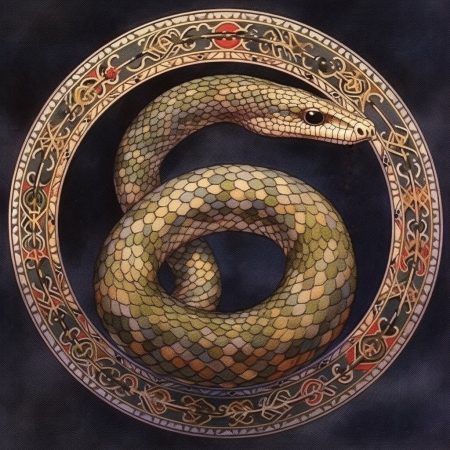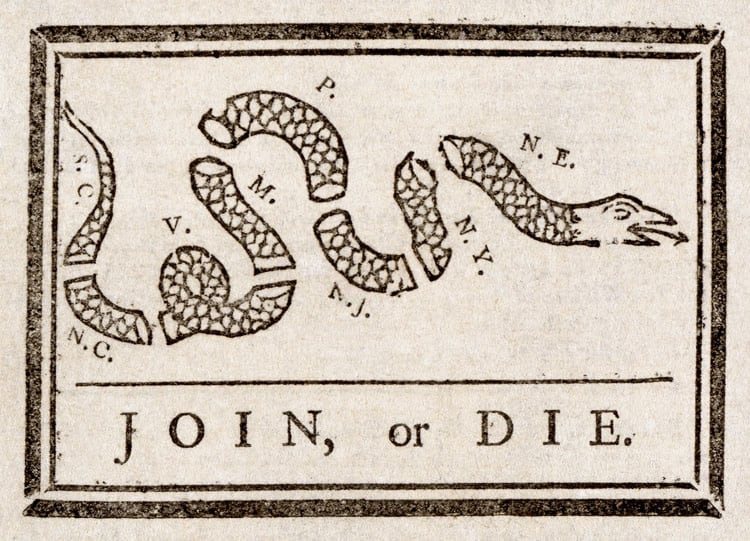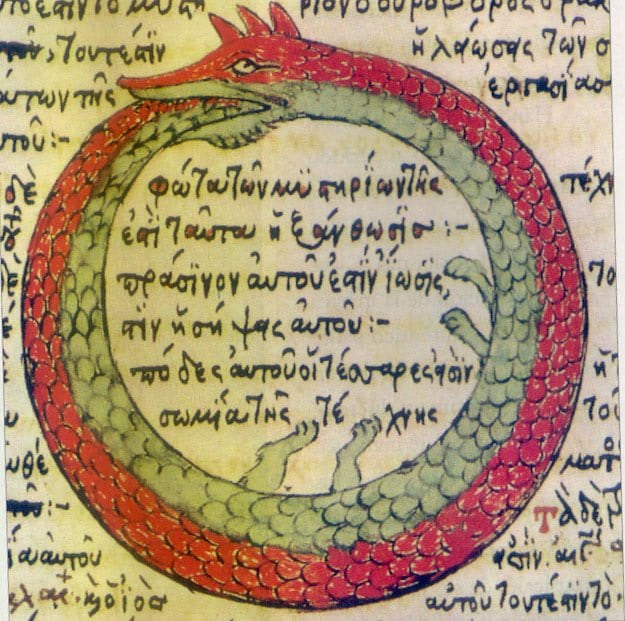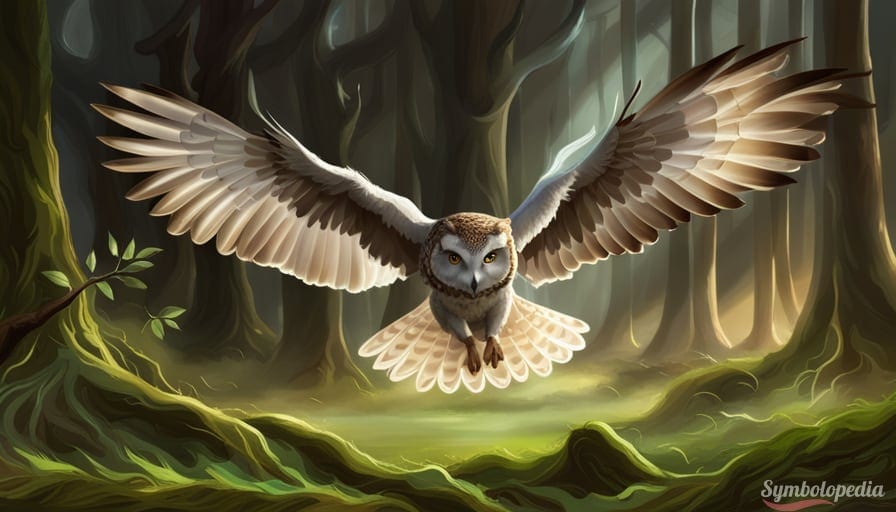Slithering into the depths of our collective imagination, snakes have long fascinated and intrigued people across various cultures and time periods. These enigmatic creatures inspire a sense of awe and wonder, as well as fear and fascination, leading to their prominent roles in myths, folklore, and spiritual practices. Dive with us into the realm of snake symbolism and meaning as we unravel the mysteries behind these captivating reptiles. Discover how their multifaceted significance touches upon themes like transformation, healing, and duality – shedding light on both our fears and our deepest desires. Prepare yourself for an enthralling journey into the world of serpentine symbolism that may shed new insights on your own life experiences.
Table of Contents
What Does a Snake Symbolize?

A snake often symbolizes transformation, rebirth, and healing due to its ability to shed its skin. Additionally, it can represent wisdom, fertility, and temptation depending on various cultural contexts.
Snakes have been linked with the concept of healing and medicine. In ancient Greece, the staffs of gods Asclepius and Hermes were adopted as symbols of medicine. It is believed that ancient healers were familiar with the immune system, and that exposure to snake venom could strengthen the body. As a result, snakes were considered symbols of renewal and protection. Additionally, they are associated with wisdom and are often linked to dragons in both Asian and Celtic cultures.
Being silent and stealthy creatures, snakes are also considered symbols of efficiency and secrecy. However, they are also seen as symbols of charm and temptation, with the story of Eve and the apple being a prime example of this. Snake charmers have also utilized them as hypnotic subjects, and they are often associated with transformation, renewal, and rebirth, particularly due to their shedding of skin. Snakes represent the ability of the mind to move from the conscious to the subconscious and back, and they exhibit spirals, a pattern that is found throughout nature and the universe, in their ability to coil. 1
Snake Symbolism in Dreams
The interpretation of dreams is a fascinating subject, however, it can be quite challenging, as it requires taking into account the dreamer’s personal associations and possibly significant events in their life. Our approach to interpreting dream symbols follows the psychological perspective.
The meaning of snake dreams can be quite unsettling and diverse, just like the vast array of snakes that exist in the world. Each individual’s interpretation of these dreams is unique, relying on their personal analysis. However, studying how these dreams have been interpreted throughout history can be enlightening. Carl Jung believed that the snake could represent both an adversary and a wise bridge that connects the right and left through longing, highlighting that not all interpretations of snakes in dreams are negative. Depending on the cultural context, snakes can signify various things such as primal, sexual creatures, oppressors, death, rebirth, health, spiritual issues, and even the phallus. Vivid or recurring snake dreams can indicate an imbalance within the dreamer, such as facing difficult decisions, feeling trapped or lonely, or experiencing relationship anxiety. Shedding skin in a dream can represent change and renewal, while dreams of constriction or snakes with multiple heads can signify oppression and paralysis. If a dreamer is surrounded or chased by snakes, it may suggest anxiety regarding the people in their life.
The practice of interpreting dreams is influenced by cultural memes that shape an individual’s upbringing. However, there are some common interpretations, including change and renewal, oppression and paralysis, relationships, sex, and sexuality. Snake dreams have also become a part of cultural iconography and have been featured in popular culture, such as the films Anaconda and Snakes on a Plane. It might be tempting to dismiss the significance of dreams, but neurological studies have revealed that brain activity during dream states is similar to that of encoding waking memories. Dreams are believed to play a crucial role in humans’ ability to face and overcome threats of all kinds without encountering real-world danger. 2 3
What Does a Dead Snake Represent?
Dreaming of a dead snake can symbolize new beginnings, growth, hidden potential, the need to move on, and the end of problems. However, the meaning of the dream depends on the dreamer’s emotions and other dream details. There are different interpretations of dead snake dreams depending on the type of snake in the dream. For example, a dream of a dead white snake may indicate that the dreamer’s lifestyle will become complex, while a dream of a dead green snake suggests that what is bothering the dreamer will come to an end. Dreaming of many dead snakes can mean that problems will end, and support will be available. Conversely, dreaming of a dead snake in bed suggests that the dreamer has matured and can deal with their insecurities, while dreaming of a dead snake that becomes alive again represents unhappiness.
The dream of a dead snake is not always positive, and each dream is unique, so its interpretation varies. Dreaming of a dead snake could indicate that the dreamer is rejecting certain aspects of themselves or holding onto negative emotions. It could also suggest that the dreamer needs to eliminate a part of themselves and move on or that someone close to them will break their trust. Dead snake dreams may also suggest that the dreamer needs to reflect on their life or focus more on their goals for growth. Overall, the dreamer should pay attention to their feelings and other dream details to interpret the meaning of a dead snake dream accurately. 4
What Does a Chasing Snake Mean?
The sight of a snake chasing you in a dream can evoke fear and anxiety, yet it can have diverse implications. One possibility is that it signifies a problem you’re trying to avoid, and the snake’s relentless pursuit suggests that you cannot completely escape it. This could imply that you’re undergoing excessive stress or anxiety in your waking life, and your subconscious is drawing attention to it. Alternatively, the dream may indicate a struggle for power that you feel helpless to overcome, whether it’s a personal conflict, a work-related challenge, or an internal battle. Furthermore, being chased by a snake symbolizes an underlying threat that’s hidden and ready to strike, possibly representing someone who has betrayed your trust or is planning to do so.
The dream of being chased by a snake can reveal a lot about the dreamer’s inner psyche. It could reveal unresolved emotions that are deeply buried in the subconscious, such as a conflict between your desires and responsibilities or conflicting values. To overcome this obstacle, it’s essential to confront it head-on. The snake’s persistent pursuit serves as a reminder that you cannot continue to run from your emotions indefinitely. Instead, you must confront them bravely and compassionately, working to address them in a positive and constructive manner. 5
What Does a Baby Snake Represent?
This dream symbol is often linked to concepts of youthfulness, growth, and fecundity. Besides, it could signify a significant transformation or metamorphosis that the dreamer is undergoing or about to undergo in their waking life.
Dreaming of baby snakes can be interpreted as a reminder to remain optimistic and accept the changes that are about to occur. It may also indicate crucial transitions that are necessary for the dreamer’s growth, a concealed threat that requires attention, or a significant barrier that is preventing the dreamer from achieving their goals. Thus, it is essential to consider the context of the dream and other symbols that may be present when attempting to decipher the meaning of a baby snake dream. 6
Symbolism and Meaning of “Join, or Die” Snake Cut Into Pieces
In 1754, Benjamin Franklin created the political cartoon and woodcut called “Join, or Die” to urge the American colonies to unite against the French and their Native allies during the onset of the French and Indian War. The cartoon depicts a snake divided into eight segments, each bearing the initials of a colony or a group of colonies. The snake emblem could have signified rejuvenation or revival, or may have been inspired by a legend of that era which suggested that a chopped snake could be revived if its parts were reassembled before sunset. Although originally intended for the French and Indian War, the image became a potent symbol for the colonial resistance against the Stamp Act and other British taxes, which eventually led to the Revolutionary War. This design is believed to be the first political cartoon to advocate for the unification of the colonies. 7

Snakes in Mythology and Folklore
Serpents and snakes have been prominent in myths and legends across the world. They can appear as ordinary snakes, magical or monstrous creatures, and are associated with both good and evil. Snakes are often used as symbols in religion, mythology, and literature to represent life and death, creation and destruction, fertility, and a creative life force. In many cultures, snakes are linked with rainbows, rain, and fertility. Additionally, as snakes shed their skin, they have become symbols of rebirth, transformation, immortality, and healing. Snakes are often depicted as guardians of the underworld and can represent hidden wisdom or sacred mysteries. However, they are also portrayed as symbols of death, evil, or treachery, especially since some snakes are poisonous and dangerous. Mythological creatures like dragons have snakelike qualities, and in various cultures, serpent gods could take any shape. 8
Snakes are traditionally associated with deception, malevolence, and temptation in Christian doctrine, stemming from Eve’s misstep in the Garden of Eden. On the contrary, in various other cultures such as ancient Greece and Egypt, as well as among indigenous North Americans, serpents represent fecundity, revival, regeneration, and even immortality. The ouroboros, a serpent that consumes its own tail, is an ancient emblem of perpetuity that embodies everlastingness.
Legend credits St. Patrick, the patron saint of Ireland, with expelling all snakes from the Emerald Isle. Snakes were deemed to signify heathenism, and the account of St. Patrick’s expulsion is believed to allegorize the displacement of pagans and the dissemination of Christianity in Ireland. Jormungand, the sea serpent in Norse mythology, grew so vast that his body encompassed all of Midgard, and he could clasp his own tail in his mouth. In Ragnarok, the ultimate combat that would culminate in the destruction of the earth, Thor killed Jormungand but perished himself, poisoned by the serpent’s venom.
In Greek mythology, Medusa, the most renowned of the Gorgons, was a woman with snakes for hair whose stare could petrify people. As per some myths, she was once a stunning woman who was transformed into a Gorgon by Athena, the virgin goddess, as punishment for her dalliance with Poseidon, the god of the sea, in one of Athena’s sanctuaries. Later, Athena helped the hero Perseus to slay Medusa by giving him a gleaming bronze shield that he used to behold the Gorgon’s reflection rather than looking at her directly. Perseus severed Medusa’s terrifying head, and her two offspring with Poseidon, Chrysaor and Pegasus, sprang out of it. Perseus affixed Medusa’s head to his shield and employed it to immobilize his adversaries in battle. 9
Tiresias, a blind seer from Greek mythology, was believed to have transformed into a woman after encountering mating snakes. He had to wait for seven years before revisiting the spot and witnessing the same snakes mating again, which reversed the spell and restored him to his male form.
In ancient Egypt, the goddess Wadjet was often depicted as an Egyptian cobra. She was believed to have nursed the infant Horus and protected Ra by coiling around his head. Cobras held divine significance in Egyptian culture and were associated with sovereignty, wisdom, authority, and leadership. They were commonly depicted on crowns, masks of pharaohs, and shrines.
The snake from the Garden of Eden is perhaps the most infamous serpent in folklore. It is said to have tempted Eve and caused the expulsion of Adam and Eve from paradise in many religious interpretations.
Snakes also feature prominently in Japanese folklore, where they symbolize rebirth, renewal, and transformation. 10
Ouroboros Symbolism and Meaning

The Ouroboros is a circular symbol depicting a snake or dragon eating its own tail. While this symbol has appeared in various cultures, it is most closely associated with Egypt, where it was found in Tutankhamun’s tomb. The image of Ouroboros covering Ra-Osiris was thought to represent the beginning and end of time. Within Egyptian iconography, the symbol represents the chaos that engulfs the world and the order and renewal that emerges from it.
In other cultures, the Ouroboros has taken on new meanings. In Gnosticism, it represents the endless cycle of death and rebirth, as well as fertility. In Hermeticism, it symbolizes the cyclic nature of death and rebirth, destruction and creation, and transformation. Alchemists adopted the Ouroboros as a symbol of the never-ending cycle of death and rebirth, while in Hinduism, the symbol is analogous to a snake consuming its own tail. Within Christianity, the Ouroboros has been given more positive interpretations as a symbol of new life, and it is also considered a symbol of infinity in modern times. 11

Read also Owl Symbolism & Meaning
Snake Tattoo Meaning
Different cultures view snakes differently, with some seeing them as protectors and guardians of sacred places and temples while others view them as symbols of health, wealth, and medicine. Snakes are also commonly associated with rebirth, renewal, and transformation due to their ability to shed their old skin and appear brand new. In some cultures, snakes represent immortality and are depicted biting their own tails or being wrapped around themselves to symbolize the cycle of life. Additionally, snakes are linked to fertility and prosperity, and they are often tied to depictions of Mother Earth. 10
Different Colored Snake Meanings
From a psychological perspective, the interpretation of snake colors in dreams can reveal subconscious thoughts and emotions. A black or dark-colored snake may indicate a sense of impending danger or foreboding in one’s life, as well as unresolved issues with past relationships that need to be addressed. A yellow or orange snake may represent feelings of happiness and joy, while a bright red snake may reflect intense passion and energy.
A green snake, on the other hand, can symbolize a sense of safety and security, encouraging the dreamer to move forward without fear or hesitation. Conversely, a red snake may serve as a warning to stop and reconsider one’s approach to a situation. Similarly, a yellow snake may indicate caution, prompting the dreamer to proceed with care.
A light-colored or yellow snake may suggest that the dreamer is afraid of the unknown or of something new, which may be preventing them from achieving their goals. A brown snake may be a sign of underlying health concerns that the dreamer needs to address.
A purple snake may represent love and passion, while an orange snake could symbolize a close relationship with a family member, such as a parent, child, or sibling. Finally, a white snake may suggest a sense of purity and innocence, highlighting a vulnerable aspect of the dreamer’s psyche that requires attention. 12
Spiritual Meaning of a Snake
Disclaimer: While Symbolopedia employs a scientific methodology to explain and investigate symbols, it is important to acknowledge that symbolic cognition may have predated human awareness. Consequently, some symbols may be more instinctively felt than intellectually comprehended. To account for this, we strive to encompass symbols from diverse fields and belief systems in our descriptions.
One significant spiritual meaning associated with snakes is their representation of spiritual healing. Symbolizing redemption, the snake offers the opportunity for growth and improvement on a spiritual level. Just as snakes shed their skin, we too can let go of negative behaviors and past experiences, actively striving for spiritual awareness and elevated consciousness. Another spiritual significance attributed to snakes is eternity, as depicted by the ouroboros symbol, where a snake consumes its own tail. This representation highlights the eternal nature of the soul. Our physical bodies are transient vessels, akin to the snake shedding its skin. When we pass away, our souls are liberated, transcending earthly limitations. Additionally, snakes symbolize spiritual awakening by embodying primal energy. When our primal or kundalini energy awakens, we embark on a profound journey of spiritual awakening and self-discovery. 1
Meditation to Connect With the Snake Spirit Animal

- Find a serene and peaceful location where you can comfortably sit or lie down, free from any distractions. Close your eyes and take several deep breaths, allowing yourself to unwind and release any tension in your body. As you continue to breathe deeply, envision yourself in a magnificent natural setting, surrounded by lush greenery and the gentle melodies of nature.
- Imagine a warm, radiant light encompassing your entire being, creating a shield of serenity and tranquility around you. Experience this light emanating from within, instilling within you a profound sense of peace and calmness.
- Now, picture a snake gracefully emerging from the foliage. Observe its elegant movements as it effortlessly glides across the earth. As the snake approaches you, embrace a feeling of curiosity and openness in your heart. You might sense a tingling sensation or a profound connection as the snake draws nearer.
- Allow the snake to come closer to you, and take notice of its patterns and vibrant colors. Pay attention to the intricate details of its scales, glistening in the sunlight. Take a moment to appreciate the beauty and wisdom embodied by this magnificent creature.
- As you connect with the snake spirit animal, embrace a deep sense of trust and surrender. Understand that the snake symbolizes transformation, healing, and intuition. Open yourself to receive these invaluable gifts.
- Envision the snake gently coiling itself around your body, establishing a sacred bond. Feel the coolness and smoothness of its scales against your skin, providing a sensation of gentle pressure and support. As the snake envelops you, imagine it infusing you with its energy, transmitting its wisdom and strength.
- Take a few moments to reflect upon areas in your life where you seek transformation or healing. Request guidance and wisdom from the snake spirit animal. Remain receptive to any insights or messages that may emerge.
- During this sacred connection, you may experience an amplified intuition. Trust the guidance that flows to you, knowing that the snake spirit animal is present to assist you on your journey.
- When you feel ready to conclude the meditation, express gratitude to the snake spirit animal for its presence and teachings. Visualize the snake gradually unwinding itself from your body and returning to its natural surroundings. Sense a gentle detachment and grounding as the snake retreats.
- Take a few more deep breaths and gradually bring your awareness back to the present moment by wiggling your fingers and toes. Open your eyes and take a moment to reflect upon your experience, acknowledging any insights or emotions that arose during the meditation.
- Carry the wisdom and energy of the snake spirit animal with you as you continue your spiritual voyage. Remember that its guidance and transformative power are always available to support you.
Snake Totem Animal
The Snake Totem Animal is a powerful symbol of transformation and healing. It is associated with wisdom, knowledge, and the ability to shed old skin in order to make room for new growth. The snake’s power lies in its ability to move between worlds — the physical world as well as the spiritual realm — with ease, allowing it access to hidden truths that can be used for personal growth. Its presence encourages us to embrace change and seek inner strength while remaining grounded during times of transition or uncertainty.
Snake Power Animal
The snake power animal embodies transformation, rebirth, healing, and feminine power. This serpent symbolism appears in various mythologies, such as Hinduism where Goddess Kali wears a garland of snakes, and Greek mythology featuring Medusa, whose snake-filled head turns men to stone. Associated with the element of water, snake power is revered by shamans for preventing droughts and maintaining agricultural growth in arid regions. Despite being mistakenly seen as a devil figure, the snake actually represents the divine feminine. Its close connection to Mother Earth facilitates a constant communion between the snake and the earth’s magnetic field. Snakes also symbolize healing and regeneration through shedding their skin—an essential reminder to let go of what no longer serves us in order to embrace new opportunities for growth. 13
Snake Encounters & Omens
As an omen, the appearance of a snake can be interpreted both positively and negatively. On one hand, snakes are considered symbols of transformation, rebirth, and healing due to their ability to shed their skin. In this context, encountering a snake might signify personal growth or a transition into a new phase of life. Conversely, snakes can also represent danger and betrayal because of their venomous nature and stealthy characteristics. In such cases, the sighting of a snake could serve as a warning sign or foreshadowing of potential threats that are lurking beneath the surface. The perception of snakes as omens is deeply rooted in cultural beliefs and personal interpretations, making them enigmatic harbingers whose messages vary depending on individual perspectives.
Snake in Astrology & Zodiac Signs
Snake holds the sixth position in the 12-year cycle of the Chinese zodiac. This mysterious and enigmatic creature is often associated with malevolence and cunning, but it also represents wisdom and divination. In ancient Chinese tradition, snakes were highly venerated, as seen in depictions of the Chinese mother goddess Nüwa, who had a snake’s body and a human head. Even today, some parts of China believe that finding a snake in one’s courtyard can bring good fortune.
People born in the Year of the Snake are known for their rationality, calmness, thoughtfulness, and loyalty to their loved ones. They possess an air of mystery that draws others towards them and are deeply perceptive individuals. Snakes are deep thinkers who approach love with devotion and steadfastness. They exhibit strengths such as talent, intelligence, modesty, perceptiveness, and inspiration while being prone to indifference, skepticism, possessiveness, and stubbornness. Snake men excel in their careers due to their keen eye for opportunities. Snake women are graceful and kind-hearted individuals who appreciate artistry and pursue various interests. 14
Snake in Books & on TV
Among the most renowned instances of serpents in pop culture is Nagini from the Harry Potter saga. Nagini, Voldemort’s faithful pet snake, participates in numerous wicked acts on his behalf. Portrayed as ferocious and devoted to her master, she intensifies the feeling of peril and unpredictability throughout the narrative.
Kaa from the Jungle Book is another prominent snake character. As a wise and formidable python, Kaa acts as one of Mowgli’s guides within the tale. Characterized by strength and wisdom, he contributes an air of mystique to the story.
Summary
Snakes have been associated with healing, medicine, wisdom, renewal, and protection. In dreams, their meaning can be both positive and negative depending on the context. For instance, a dead snake may symbolize new beginnings or growth, while being chased by a snake might signify underlying threats or unresolved emotions.
Snakes are prominent in mythology and folklore as well. In some religious interpretations, they represent deception and malevolence. However, in other cultures like ancient Greece and Egypt as well as among indigenous North Americans, serpents symbolize fertility, revival, regeneration, and even immortality.
FAQ
What does snake symbolism represent in various cultures?
In various cultures, snakes have been associated with different meanings and symbolism. In ancient civilizations, such as Egypt and Mesopotamia, snakes were considered symbols of protection, healing, and immortality. In Hinduism, the snake is often associated with Kundalini energy and spiritual awakening. In ancient Greek mythology, snakes represented wisdom and knowledge due to their association with Asclepius (the god of medicine) and Athena (the goddess of wisdom). However, in Christianity, the snake is most commonly seen as a symbol of evil or temptation.
What is the significance of snake symbolism in dreams?
Snake symbolism in dreams can hold various interpretations depending on the context and emotions accompanying the dream. Generally, dreaming about snakes may represent personal transformation or growth since they shed their skin to grow. A snake may also symbolize hidden fears or repressed desires that need to be confronted. In some cases, a snake dream could signify healing and regeneration due to its association with ancient medical symbols like the Rod of Asclepius.
How are snakes connected to spirituality?
Snakes have long been linked to spiritual themes across multiple traditions and beliefs systems. In Hinduism and Buddhism, serpents are related to Kundalini energy – a potent force located at the base of the spine that can be awakened through meditation or yoga practices for spiritual growth. Native American spirituality often associates snakes with renewal and rebirth because they shed their skin in a continuous cycle of regeneration. Additionally, some African religions consider snakes as embodiments of ancestral spirits or deities associated with fertility.
What role do snakes play in folklore and mythology?
Throughout history, snakes have appeared in countless stories, myths, and legends across diverse cultures worldwide. They often take on roles representing both good and evil forces or embodying dualistic qualities like life/death, creation/destruction, and wisdom/temptation. For example, in Aztec mythology, the feathered serpent god Quetzalcoatl is considered a creator deity and symbolizes knowledge and learning. Conversely, in the Biblical story of Adam and Eve, the serpent represents temptation that leads to humanity’s fall from grace.

Reviewed by Alexander Lys, M.L., a specialist in the field of symbolism research and dream psychology. A certified participant in numerous psychological seminars and courses, the author of hundreds of articles on psychology, including studies on symbolism in dreams and myths from a scientific perspective.
- https://www.uniguide.com/snake-symbolism-meaning-spirit-animal[↩][↩]
- https://www.psychnewsdaily.com/dreams-about-snakes/[↩]
- https://www.dreams.co.uk/sleep-matters-club/snake-dream-meaning[↩]
- https://thepleasantdream.com/dreaming-of-a-dead-snake/[↩]
- https://www.worldofdreams.com/dream-dictionary/dreaming-of-a-snake-chasing-you/[↩]
- https://insidemydream.com/dream-of-baby-snakes/[↩]
- https://mrnussbaum.com/join-or-die-the-story-behind-ben-franklin-s-iconic-woodcut[↩]
- http://www.mythencyclopedia.com/Sa-Sp/Serpents-and-Snakes.html[↩]
- https://www.history.com/news/snake-symbol-history-mythology[↩]
- https://www.savedtattoo.com/snake-tattoo-meaning/[↩][↩]
- https://symbolsage.com/ouroboros-meaning-and-origins/[↩]
- https://alodreams.com/colorful-snake-dream-meaning.html[↩]
- https://worldbirds.com/snake-symbolism/[↩]
- https://www.travelchinaguide.com/intro/social_customs/zodiac/snake.htm[↩]


